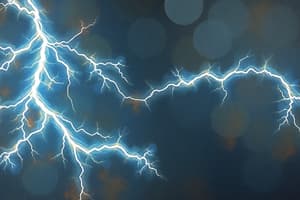Podcast
Questions and Answers
What is the primary reason that conductors can conduct electricity?
What is the primary reason that conductors can conduct electricity?
- They have loosely bound outer electrons. (correct)
- They lack free electrons.
- They are made of nonmetallic materials.
- They contain positively charged ions.
What is the conventional direction of electric current?
What is the conventional direction of electric current?
- From the negative terminal to the positive terminal.
- From the center of the battery to the outer edges.
- In random directions throughout the circuit.
- From the positive terminal to the negative terminal. (correct)
What happens to the outermost electrons in a conductor when they gain extra energy?
What happens to the outermost electrons in a conductor when they gain extra energy?
- They are easily lost and become free. (correct)
- They become positively charged particles.
- They remain bound to the nucleus.
- They increase their mass significantly.
What is required for electric current to flow in a circuit?
What is required for electric current to flow in a circuit?
When considering the actual direction of electric current, it is caused by the movement of which particles?
When considering the actual direction of electric current, it is caused by the movement of which particles?
What characterizes conductors in terms of electric charge flow?
What characterizes conductors in terms of electric charge flow?
Which material is classified as a semiconductor?
Which material is classified as a semiconductor?
What is the primary reason insulators do not conduct electricity?
What is the primary reason insulators do not conduct electricity?
Which statement is true about electric current?
Which statement is true about electric current?
What distinguishes semiconductors from conductors and insulators?
What distinguishes semiconductors from conductors and insulators?
Flashcards
Free electrons in a conductor
Free electrons in a conductor
Outermost electrons in a conductor that are loosely bound and easily move.
Conductor
Conductor
Material with many free electrons allowing it to conduct electricity.
Electric Circuit
Electric Circuit
A closed path for electric current to flow.
Conventional Current
Conventional Current
Signup and view all the flashcards
Actual Current
Actual Current
Signup and view all the flashcards
Battery in an electric circuit
Battery in an electric circuit
Signup and view all the flashcards
Electric Current
Electric Current
Signup and view all the flashcards
Conductors
Conductors
Signup and view all the flashcards
Semiconductors
Semiconductors
Signup and view all the flashcards
Insulators
Insulators
Signup and view all the flashcards
Electricity
Electricity
Signup and view all the flashcards




